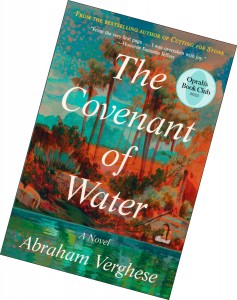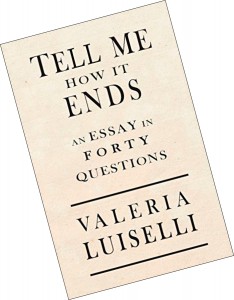A solid, absorbing read Everyone’s talking about Abraham Verghese’s latest offering, so we might as well too. Among other things.
A clip doing the rounds on YouTube features Oprah Winfrey talking to Abraham Verghese about his latest book, The Covenant of Water. Heaping praise, she said it featured among her top three books of all time, including a Toni Morrison. ‘And I’ve been reading since age 3,’ she added.
This practising doctor and author of four books, a professor of the theory and practice of medicine, and now vice-chair of Education at Stanford University Medical School is an alumnus of Madras Medical College. His first two books — My Own Country and The Tennis Partner — are based on his experiences in medicine. For the third, Cutting for Stone, he turned to fiction. Successfully. The book was on the New York Time’s bestseller list for two years, apart from winning several accolades.
That Verghese is serious about his writing in the way that he is serious about his medical profession is borne out by the fact that he took a break from medicine and earned a Master of Fine Arts degree by enrolling for the Iowa Writers Workshop at the University of Iowa, one of the most sought-after writing courses in the world. My Own Country, published a couple of years later, reveals the fluidity of his thought process and the lucidity of his writing style. Detailed, yet engaging; probing, yet mindful; of the world, yet rooted. And in that clip with Oprah, he reiterates that for him, practising medicine overrides everything else. You see it in all his writings: medicine overlays, underlies, permeates. Additionally, there is art and craft and absorbing storytelling. In many ways, Abraham Verghese bears out a long-harboured personal theory: the busiest people somehow manage to make not just the most time, but the most of their time.
Luiselli, in her book Tell me how it ends, tries to show us what the children are fleeing from and the challenges they face as they are caught between the ‘ideals of the American dream’ and the ‘reality of American racism and fear’.
This Kerala story — radically different from what’s being currently peddled on the screen and in discussions on various platforms — is real and palpable, enriched and rendered fertile by the inexorable presence of water. According to some accounts, there are some 50 rivers in Kerala, 35 lakes, apart from backwaters, reservoirs, ponds… Relationships with water, naturally, is the leitmotif of the book, in which the story emerges like doors opening, one after the other, with the social, physical, political, cultural, religious and individual nuances of people in the places they inhabit steadily being interwoven into a strong and seamless bale of cloth. And even if at times it seems as though it addresses — some may say, seems to dress up — a largely western audience, the fabric holds together.
The narrative begins in Travancore, in 1900, where a 12-year-old is shown lying on the mat with her mother. She will be married in the morning to, as it turns out, a 40-year-old widower with a small son. From there the saga surges forward for nearly 80 years, through three generations. The little girl is central to the novel as she grows into womanhood and later becomes a grandmother. Lives encounter highs and lows as the world recreated in the pages enlarge with details being added in gradually. You linger over descriptions of the tharavad, the kitchen, the river, the walking paths, the hospital, the patients, the soirees… and slowly, ever so slowly, secrets begin to tumble out, connections are unravelled. Sometimes the descriptions read like explanations or monologues, but that does nothing to interrupt the flow because the writing is facile, rich, layered. There is drama without the dramatic.
It is a slow read. Therefore, as the name of a bookstore in Lisbon suggests, Ler Devagar, ‘read slowly’. This piece of advice, in Portuguese, is just the mantra for hot summer afternoons and long, leisurely train rides. I read slowly, but steadily, every day.
Tell Me How It Ends: An Essay in Forty Questions by Valeria Luiselli is a short but eye-opening account of another kind of journey. The real and dangerous routes undertaken by children forced to escape from unimaginable horrors in countries like the Honduras, Guatemala, El Salvador, through Mexico and into the United States, in search of a fundamental right: safety. All refugees slipping into the US are labelled ‘undocumented aliens’. Luiselli revisits this troubling matter even as today, there appears to be increasing resistance to immigrants, even though you see them everywhere in the US: repairing roads, doing housework, even running vegan cafes. While large numbers of Mexicans seek asylum in the US, the irony, we learn from this book, is that immigrants from Central America are treated harshly by the Mexican government itself.
According to an article from the Council on Foreign Relations about US detention of child migrants, in 2022, ‘immigration authorities encountered more than 152,000 unaccompanied minors at or near the US-Mexico border,’ apparently ‘an all-time high’. Luiselli tries to show us what the children are fleeing from and the challenges they face as they are caught between the ‘ideals of the American dream’ and the ‘reality of American racism and fear’. You realise that behaviours, attitudes, and rigid politico-legal systems are not restricted to the US; they prevail all across the globe, including India.
The Holocaust, Partition, and George Floyd, Gowri Lankesh, Safdar Hashmi, the anti-Sikh riots, Babri Masjid, the Kumbakonam school fire, the farmers’ agitation, the wrestlers’ protests… all these stories have to be aired and shared.
The 40 questions refer to the questionnaire presented to the children by US immigration. Luiselli, herself of Mexican origin, is a novelist who worked as a volunteer interpreter at the federal immigration court in New York City, interviewed children following the intake questionnaire, translated their stories from Spanish into English, met with lawyers to explain the notes and transcriptions. Beginning with ‘why did you come and when,’ through ‘did anything happen on your trip to the US that scared you or hurt you’ and ‘did you stay in touch with your parents,’ the horror of the journey, the dangers encountered, the fear that often renders the children speechless, apart from unfamiliarity with the English language… all of this can be mapped and the mental condition of the children imagined, provided the attorney has the bandwidth and/or the compassion. By the time, the last few questions come around — What do you think will happen if you go back home? Are you scared to return? Who would take care of you if you were to return to your home country? — we get the full picture; we see how children are raped, robbed, even killed on the way. And most importantly, why they cannot afford to be deported, which in most instances they are.
Towards the end of the essay, Luiselli writes, ‘There are things that can only be understood retrospectively, when many years have passed and the story has ended. In the meantime, while the story continues, the only thing to do is tell it over and over again as it develops, bifurcates, knots around itself. And it must be told, because before anything can be understood, it has to be narrated many times, in many different words and from many different angles, by many different minds.’
That is why the Holocaust, Partition, Trayvon Martin and George Floyd, Gowri Lankesh, Safdar Hashmi, the anti-Sikh riots, Babri Masjid, the Kumbakonam school fire, the Peshawar school massacre, the Rwandan civil war, the farmers’ agitation, the wrestlers’ protests… all these stories have to be aired and shared. Not only so they are remembered, not only so they are not repeated, but also so that these narratives are not changed through lies. Only by converting to compassion and truth-telling can we eliminate ignorance, fear and hatred. Reading helps in the process.
The columnist is a children’s writer and senior journalist


